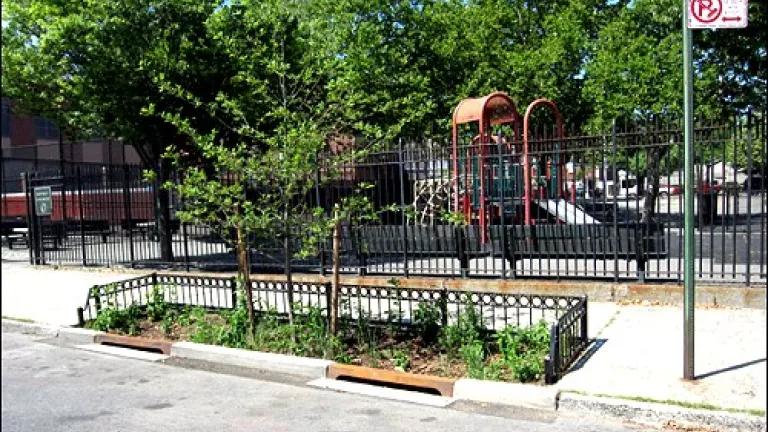
New York City, like hundreds of older cities around the country, can't stand the rain. With so much paved area, and so little ground to soak up the water, the city's sewer system can get overwhelmed by a mere tenth of an inch of rainfall, triggering the discharge of polluted runoff from streets mixed with untreated sewage into the nearest water body. Anyone who’s walked along the Hudson River the morning after a storm knows what this looks like.
For New York, excess stormwater is one of the biggest sources of water pollution in the city. It's a 30-billion-gallon-a-year problem.
The traditional approach to stormwater management is to treat it like garbage, as waste that needs to be disposed of. But a growing number of cities have recently embraced an innovative new approach to stormwater that transforms this “waste” into a resource that will improve neighborhoods. By building out a suite of solutions known as green infrastructure--including features like porous pavement, street plantings, and green roofs—city landscapes can absorb rainwater where it falls. Instead of washing straight into the sewer system and triggering sewage discharges, this water can be used as nature intended, to nurture trees and plants, keeping neighborhoods cooler, greener, and the air cleaner.
This street planting outside a Brooklyn playground is one of the city's pilot projects. By expanding the planted area around a streetside tree, using native plants and specially engineered, absorbent soil, city engineers have created a system that can absorb nearly 1,000 gallons of stormwater runoff, which would have previously been mixed with sewage and ejected directly into Jamaica Bay. The tree box also has extra storage chambers underground, which can hang on to extra water and slowly release it for the trees to drink.
The city plans to eliminate 1.5 billion gallons of water waste each year through green infrastructure, and aims to save billions of dollars as compared to the cost of building conventional "gray" infrastructure, such as pipes and large storage tanks.
"It’s particularly important for the State and City to leverage innovative, cost-effective solutions like these when there are competing social needs and taxpayer dollars must deliver more services for less, said city councilman James F. Gennaro, who supported the plan. Business leaders are on board with the effort as well, praising its cost-effectiveness and the use of public and private properties for stormwater management.
Philadelphia has an even more ambitious green infrastructure plan, and other cities are exploring the idea as well. Using green infrastructure to stop water waste is a radical departure from the norm, and it's incredibly encouraging to see the idea take root. Stopping waste, even though it makes perfect sense, sometimes requires a change in thinking--and when it happens, the ripple effects can spread far and wide.
This post is part of our Wasteland series, featuring people, towns, businesses and industries that are finding innovative ways to cut waste, boost efficiency and save money, time and valuable resources.
